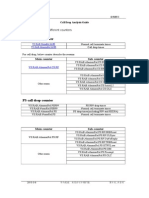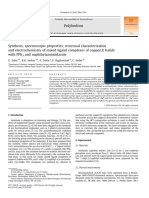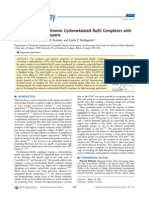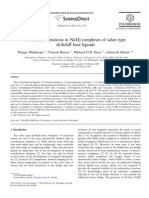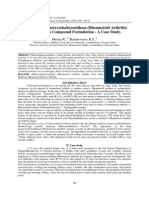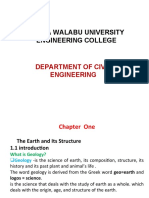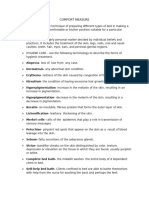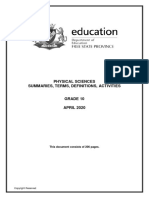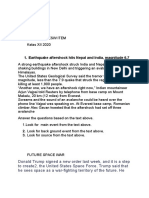G 044028042
G 044028042
Uploaded by
IOSR Journal of PharmacyCopyright:
Available Formats
G 044028042
G 044028042
Uploaded by
IOSR Journal of PharmacyOriginal Title
Copyright
Available Formats
Share this document
Did you find this document useful?
Is this content inappropriate?
Copyright:
Available Formats
G 044028042
G 044028042
Uploaded by
IOSR Journal of PharmacyCopyright:
Available Formats
IOSR Journal Of Pharmacy
(e)-ISSN: 2250-3013, (p)-ISSN: 2319-4219
www.iosrphr.org Volume 4, Issue 4 (April 2014), PP.28-42
28
Synthesis, Characterization, Structural Interpretation, Biological
Activity and DNA Cleavage Studies of 3-acyl 2-(2hydroxy-5-X
phenyl) Benzothiazoline Cu (II) Complexes
B.Aparna
1
, K.Sudeepa
1
, Dr. Muthukumaresan Kuppusamy Thirumalai
2
,
P. Mamtha
3
, Sujitha Pallemoni
4
, Ch. Sarala Devi
4
*
1
Department of Chemistry, Nizam College, Osmania University, Hyderabad-500 001, A.P, India.
2
SRM Research Institute, SRM University, Kattankulathur, Chennai-603203, T.N, India.
3
Departments of Chemistry, Womens College, Osmania University, Hyderabad-500 095, A.P, India.
4
*Department of Chemistry, Osmania University, Hyderabad-500 007, A.P, India.
ABSTRACT: Benzothiazolines and other compounds containing NC
6
H
4
S- are reported to have biological
activity. The ligand 3-acyl 2-(2hydroxy-5-X phenyl)benzothiazoline (X=H, Cl, NO
2
, OCH
3
) forms complexes
[Cu(L-H)] which have been characterised by various spectro-analytival techniques such as elemental analyses,
magnetic moments, molar conductance, electronic, mass, ESR, TGA and IR spectral measurements. Room
temperature ESR spectra of Cu(II) complexes inferred g values characteristic of square planar geometry and
square pyramidal geometry. The QSAR and molecular properties of title compounds were computed by
employing HyperChem 7.5 tools. The title compounds and their corresponding Cu(II) complexes were assayed
by the agar disk diffusion method for antibacterial and antifungal action against E. coli, S. marcescens, P.
aeruginosa, S. aureus, B. Subtilis and C. Albicans respectively. The DNA cleavage studies on PBR322 DNA
indicated the hydrolytic cleavage by Cu (II)-AHNPBT, wherein super coiled DNA (form I) is converted into
relaxed and linear DNA (form II & form III).
Keywords: Benzothiazoline, Cu (II) complexes, DNA Cleavage studies, ESR studies
I. INTRODUCTION
The coordination chemistry of nitrogen-oxygen donor ligands is an interesting area of research. Many
studies on benzothiazoline have been made because of their structural interest. Namely, they contain two
different heteroatoms linked by one carbon. Benzothiazolines and other compounds containing NC
6
H
4
S- are
reported to have biological activity
[1]
. A large number of benzothiazolines have been prepared by the reactions
of aldehyde and ketones with 2-aminothiophenol
[2-4]
. Benzothiazolines constitute an important class of bidentate
as well as multidentate ligands
[5-7]
.The use of these Lewis base functionalized ligands can be effective in
increasing the coordination number of the central metal atom at the expense of the benzothiazoline ring to the
corresponding Schiff base derivatives, leading to the greater stability of the resulting compounds.
Keeping this in view, we have synthesised new complexes of Cu(II) with 3-acyl 2-(2hydroxy-5-X
phenyl)benzothiazoline (I), X=H, Cl, NO
2
, OCH
3
as ligand (Fig. 1) and described and discussed a preliminary
investigation of their structure.
S
N
C O
CH H
H
OH
X
H
Figure 1
(Ia), AHPBT, X=H
(Ib), AHCPBT, X=Cl
(Ic), AHMPBT, X=OCH
3
(Id), AHNPBT, X=NO
2
II. EXPERIMENTAL
2.1. Chemicals
Starting materials are commercial reagents, 2-aminothiophenol from Alfa Aesar Lancaster, 5-X
salicylaldehydes (where X= H, Cl, NO
2
, OCH
3
) from Sigma Aldrich and Copper Chloride from SD`s fine
chemicals. All the chemicals and solvents used were dried and purified by standard methods. The moisture was
excluded from the glass apparatus using CaCl
2
. Experiments were performed at room temperature.
Synthesis, Characterization, Structural Interpretation, Biological...
29
2.2. Instrumentation
The MS data was collected on Agilent Single Quad Mass Spectrometer. The IR Spectra (KBr) was
recorded on a Bruker Optics Tensor-27 FTIR. Molar conductivities of the complexes were measured in DMSO
at room temperature using Digison conductivity instrument.
The thermal studies were carried out in a dynamic nitrogen atmosphere (20 ml min-1) with a heating
rate of (10
o
C min-1) using a Shimadzu TGA-50H. Electronic spectra were recorded using a UV-Vis 2450
Schimadzu spectrophotometer. ESR spectra were registered on a Varian E112 type spectrophotometer. The
measurements were done in the L band in air atmosphere at room temperature. The melting points were
determined with Polmon apparatus (Model No.MP-90).
2.3. Synthesis of the ligand
The 3-acyl-2-(2-hydroxy-5-X phenyl) benzothiazoline was formed by condensation of 2-
aminothiophenol with 5-X salicylaldehyde (where X=H, Cl, NO
2
and OCH
3
) in equimolar ratio in a polar
solvent. Acylation of the 3-amino group was achieved by using acetic anhydride
[8]
. The resultant 3-acyl-2-(2-
hydroxy-5-X phenyl) benzothiazoline is recrystallized using suitable solvents.
2.4. Synthesis of the complexes
A mixture of title compound (0.005 mol) and anhydrous CuCl
2
(0.005 mol or 0.01 mol) in methanol
medium was refluxed on water bath for 8-10 hours at 70-80 C by adjusting pH in the range 6.0-7.0 to enable
complex formation. The precipitated complex was filtered off, washed with water, hot ethanol and dried in
vacuum at room temperature. The product was dried in air and stored in a desiccator over anhydrous CaCl
2
under vacuum.
III. RESULTS AND DISCUSSION
The new copper complexes synthesized in the present investigation have melting points higher than
300
0
C. The elemental analyses data along with some physical properties of the complexes are reported (Table
1). All the metal complexes are coloured and stable to air and moisture. They are soluble in DMF and DMSO,
but insoluble in other organic solvents.The molar conductivities of the complexes in DMSO were found to be
3.0-5.0
-1
cm
2
mol
-1
(Table 1) suggesting their non-electrolytic nature.
Table 1: Mass Spectral data, Molar conductivity and Magnetic moment values
No. Compound Molecular Formula Colour
Mass
Spectral
Data
^
-1
cm
2
mol
-1
eff
(BM)
(1)
Cu-AHPBT Cu-C
15
H
13
NO
2
S Cl.H
2
O
Light
Brown
391
3.2
2.13
(2)
Cu-AHCPBT
Cu-C
15
H
13
NO
2
ClS Cl. H
2
O
Brown
423
3.1
1.81
(3)
Cu-AHMPBT
Cu-C
16
H
15
NO
3
SCl.(H
2
O)
2
Dark Brown
435
3.4
1.60
(4)
Cu-AHNPBT Cu-C
15
H
12
N
2
O
4
SCl.H
2
O
Yellowish
Brown
432
3.5
1.63
3.1. Infrared Spectra
The comparative IR spectral study of the ligands AHPBT, AHCPBT, AHMPBT and AHNPBT and
their Cu(II) complexes reveals the coordination mode of the ligand during the complex formation. The IR
spectrum of the ligands (Table 2) shows bands at 3130-3226 cm
-1
due to the presence of OH group, which is
absent in complexes and a small broad peak is observed in the region 3323-3446cm-1 indicating the
participation of OH group in complex formation. The C=O stretching vibration is also shifted to the lower
frequencies. The nature of the metal-ligand bonding is confirmed by the newly formed bands at ~ 550 cm
-1
and
~ 470 cm
-1
in the spectra of complexes(Fig. 2-5), which is tentatively assigned to Cu-O and Cu-N vibrations
[9-
11]
.
Synthesis, Characterization, Structural Interpretation, Biological...
30
Table 2: IR bands and their assignments for 3-acyl 2-(2hydroxy-5-X phenyl) benzothiazoline (Ia-d) and
its Cu complexes (1)-(4).
No. Compound
C=O
C-X
OH/H2O
Cu-O/Cu-N
(Ia) AHPBT 1635 - 3211 -
(1) Cu-AHPBT 1608 - 3446 551/472
(Ib) AHCPBT 1620 740 3165 -
(2) Cu-AHCPBT 1604 742 3433 570/450
(Ic) AHMPBT 1631 1423 3226 -
(3) Cu-AHMPBT 1620 1453 3323 543/470
(Id) AHNPBT 1689 1334 3130 -
(4) Cu-AHNPBT 1605 1328 3338 561/462
Figure 2: IR Spectrum of Cu-AHPBT
Figure 3: IR Spectrum of Cu-AHCPBT
Synthesis, Characterization, Structural Interpretation, Biological...
31
Figure 4: IR Spectrum of Cu-AHMPBT
Figure 5: IR Spectrum of Cu-AHNPBT
3.2. Electronic spectra
The electronic spectra of Cu (II) complexes are compared with those of the ligands (Fig. 6-9). Two
bands appeared at 38610-39840 cm
-1
and 28735-30487 cm
-1
, which can be assigned to -* and n-* transitions,
respectively, in all the ligands. The electronic spectra of complexes showed low energy bands at 10437-16420
cm
-1
and a strong high energy band at 23310-28328 cm-1. The low energy band in the position may be assigned
to the transitions dx
2
-y
2
dyz; dz
2
; dxy
[12-13]
. The strong high energy band is assigned to metalligand charge
transfer. The observed magnetic moment values (Table 1) for the complexes also support for the same.
Synthesis, Characterization, Structural Interpretation, Biological...
32
400 600 800
0.0
0.2
0.4
0.6
0.8
1.0
1.2
1.4
--Cu-AHPBT
--AHPBT
A
b
s
o
r
b
a
n
c
e
Wavelength
400 600 800
0.0
0.2
0.4
0.6
0.8
1.0
1.2
--Cu-AHCPBT
--AHCPBT
A
b
s
o
r
b
a
n
c
e
Wavelength
Figure 6: UV Spectrum of Cu-AHPBT Figure 7: UV Spectrum of Cu-AHCPBT
400 600 800
0.0
0.5
1.0
1.5
2.0
--Cu-AHMPBT
--AHMPBT
A
b
s
o
r
b
a
n
c
e
Wavelength
400 600 800
0.0
0.2
0.4
0.6
0.8
--Cu-AHNPBT
--AHNPBT
A
b
s
o
r
b
a
n
c
e
Wavelength
Figure 8: UV Spectrum of Cu-AHMPBT Figure 9: UV Spectrum of Cu-AHNPBT
3.3. Mass Spectra
The mass spectra of the metal complexes are presented in (Fig.10-13) and the analysed data is presented in
(Table 1). All the complexes show m/z peaks which are in accordance with the expected mass. The mass spectra
confirm that metal complexes are formed in 1:1 ratio.
Synthesis, Characterization, Structural Interpretation, Biological...
33
Figure 10: Mass Spectrum of Cu-AHPBT
Figure 11: Mass Spectrum of Cu-AHCPBT
Synthesis, Characterization, Structural Interpretation, Biological...
34
Figure 12: Mass Spectrum of Cu-AHMPBT
Figure 13: Mass Spectrum of Cu-AHNPBT
3.4. EDS Analysis
The EDS analysis of all the ligands and their Cu-complexes (Fig. 14-17) shows that the elemental
composition is in agreement with the calculated values. The data confirms the 1:1 composition of the metal
complexes.
Synthesis, Characterization, Structural Interpretation, Biological...
35
Figure 14: EDX image of Cu-AHPBT Figure 15: EDX image of Cu-AHCPBT
Figure 16: EDX image of Cu-AHMPBT Figure 17: EDX image of Cu-AHNPBT
3.5. ESR Studies
In general the ESR spectral data of a metal complex provides not only information of metal ion
geometry but also metal ligand bond covalency. The L band ESR spectra recorded at RT for the copper
complexes in the present investigation (Fig.18-21) show well resolved peaks indicating hyperfine interactions.
In all copper complexes under study the g value is nearly isotropic (Table 3). The hyperfine components are
well resolved in Cu-AHBT and Cu- AHNBT complexes while in Cu-AHCPBT and Cu- AHMPBT systems the
resolution of hyperfine components is relatively less.
Table 3: g values of Cu-Complexes
Complex g factor
Cu-AHPBT 1.8677
Cu-AHCPBT 2.0016
Cu-AHNPBT 1.8678
Cu-AHMPBT 2.0711
The analysis of intensities of peaks is useful in predicting the covalent character in complexes. The
copper nuclear spin being 3/2 , and one copper nuclei (n = 1) interaction through Fermi contact term with
electron spin would split two spin energy levels into each four hyperfine components (m
S
= +, m
I
= +3/2,
+1/2, -1/2, -3/2 and m
S
=- , -3/2 , -1/2+, +1/2, 3/2 and as per selection rules (m
S
= 1and m
I
= 0) the
four transition are allowed.
Synthesis, Characterization, Structural Interpretation, Biological...
36
Figure 18: ESR Spectra of Cu-AHPBT
Figure 19: ESR Spectra of Cu-AHCPBT
Further splitting due to super hyperfine interactions with nuclear spin of nitrogen (I
N
=1) of thiazoline ring and
hydrogen ( I
H
=1/2) of chiral ring carbon would result a total of twenty four lines with equal intensities. While in
the spectra of copper complexes, the total number of peaks recorded is eighteen wherein six peaks have double
intensity. This observation is ascribable to overlap of peaks resulting in six double intensity peaks (1:2:1, 1:2:1,
1:2:1, 1:2:1, 1:2:1, 1:2:1). Analysis of intensities of peaks thus corresponds to expected number of super
hyperfine components.
Synthesis, Characterization, Structural Interpretation, Biological...
37
Figure 20: ESR spectra of Cu-AHMPBT
Figure 21: ESR spectra of Cu-AHNPBT
Thus the results of ESR spectra are more informative and are in supportive of delocalization of
unpaired electron in complexes as electron spends some time on ligand moiety which would be possible only
with metal ligand overlap of orbitals accounting for covalent character in all complexes of present investigation.
3.6. Thermo gravimetric Analysis of Cu-AHPBT, Cu-AHCPBT, Cu-AHMPBT and Cu-AHNPBT
The TGA curves of all the copper complexes (Fig. 22-25) exhibited weight loss in the range of 200 -
300
0
C, indicating the loss of coordinated water. The gradual loss of weight in subsequent steps from 400 to 500
0
C corresponds to the partial decomposition of complex. The percentage of final residue remaining above 900
0
C indicates the formation of thermally stable residue.
Synthesis, Characterization, Structural Interpretation, Biological...
38
0.00 200.00 400.00 600.00 800.00 1000.00
Temp [C]
0.00
2.00
4.00
6.00
8.00
mg
TGA
266.88 x10
0
C Start
994.10 x10
0
C End
-4.026 x10
0
mg
-58.654 x10
0
%
Weight Loss
Ch2 Cu-AHPBT 12-37 2013-05-08.tad TGA
Figure 22: TGA Curve of Cu-AHPBT
0.00 200.00 400.00 600.00 800.00 1000.00
Temp [C]
0.00
2.00
4.00
6.00
8.00
mg
TGA
170.85 x10
0
C Start
991.67 x10
0
C End
-3.817 x10
0
mg
-64.937 x10
0
%
Weight Loss
Ch2 Cu-AHCPBT 10-47 2013-05-13.tad TGA
Figure 23: TGA Curve of Cu-AHCPBT
Synthesis, Characterization, Structural Interpretation, Biological...
39
0.00 200.00 400.00 600.00 800.00 1000.00
Temp [C]
0.00
2.00
4.00
6.00
mg
TGA
188.40 x10
0
C Start
989.91 x10
0
C End
-2.763 x10
0
mg
-63.313 x10
0
%
Weight Loss
Ch2 Cu-AHMPBT 13-54 2013-05-08.tad TGA
Figure 24: TGA Curve of Cu-AHMPBT
0.00 200.00 400.00 600.00 800.00 1000.00
Temp [C]
6.00
7.00
8.00
9.00
10.00
11.00
mg
TGA
77.25 x10
0
C Start
384.11 x10
0
C End
-3.484 x10
0
mg
-31.171 x10
0
%
Weight Loss
392.13 x10
0
C Start
991.71 x10
0
C End
-1.834 x10
0
mg
-16.409 x10
0
%
Weight Loss
Ch2 Cu-AHNPBT 13-14 2013-05-09.tad TGA
Figure 25: TGA Curve of Cu-AHNPBT
A survey of literature reveals that aryl benzothiazolines when interact with metal ions to form solid
complexes, various structural changes occur in ligands
[14-17]
. The studies on 2-(2-hydroxy) phenyl
benzothiazoline complexes revealed that in presence of Cu(II) metal ion the cleavage of thiazoline ring,
subsequent schiff base formation through the transfer of proton from nitrogen to sulphur and then dissociation
of same proton from sulphur and second proton from hydroxyl group of phenyl ring occurred enabling its
copper complex formation
[18]
. In present study as the ring cleavage is hindered by acetyl group at ring nitrogen,
in presence of metal ions under the conditions of metal complex formation, only one proton dissociation occurs
and the benzothiazoline ring remain as such.
FT-IR spectrum and the ESR studies reveal that the ligand is coordinated to the metal centre via the N
of thiazoline ring and O of phenyl ring upon deprotonation of the H from O-H leading to the possible formation
of 6-membered ring. Based on the above data the following structure can be tentatively assigned to the
complexes (Fig. 26).
Synthesis, Characterization, Structural Interpretation, Biological...
40
N
O
S
H
M
Cl
OH
2
CO
CH
3
X
Figure 26
3.7 QSAR Studies
In the present investigation the QSAR parameters were computed employing HyperChem 7.5 software.
QSAR properties like surface area, volume, hydration energy, log P, refractivity, polarisability and mass were
determined by single point method (Table 4). QSAR properties enable to estimate a variety of molecular
descriptors. The QSAR data analysis represents an attempt to relate structural descriptors of compounds with
their physicochemical properties and biological activities.
Table 4: QSAR Parameters and Molecular Properties
Property AHBPT AHBCPT AHBNPT AHBMPT
Surface area(A
2
) 337.98 380.83 412.32 405.54
Surface area grid(A2) 454.18 476.07 494.81 497.66
Volume(A
3
) 756.4 795.82 819.72 832.08
Hydration
Energy(Kcal/mol)
-4.42 -8.16 -11.6 -7.99
Log p 5.21 6.33 5.76 5.56
Refractivity(A
3
) 76.7 77.97 80.49, 79.63
Polarisability(A
3
) 32.39 33.77 33.68 34.31
Mass(amu) 271.33 305.78 316.33 301.36
PKa 9.06 8.52 8.33 8.72
Total
Energy(Kcal/mole)
-67076 -74111 -84030 -77324
Dipole Moment (D) 4.477 1.964 7.041 2.844
3.8 Biological Studies
3.8.1 Antibacterial and Antifungal Activity
The potential antimicrobial activity of the ligands and their new complexes towards five standard
bacterial strains (E. coli, S. marcescens, P. aeruginosa, S. aureus, B. Subtilis) and one fungal strain (Candida
Albicans) was investigated.
Qualitative determination of antimicrobial activity was done using the disk diffusion method
[19-21]
. A loop full
of microorganism was inoculated in 10 ml nutrient medium (NM) and incubated for 12-16 hours at 37 + 1C.
Later, 200 L of the overnight culture was transferred into fresh 10 ml NM and grown up to mid logarithm
phase (0.4 - 0.5
620
). The microorganisms were then washed twice with sterile saline pH 7.4 and resuspended in 1
ml of PBS (phosphate buffer saline) to concentration of 1-2 X 10
9
CFU/ml. Subsequently, bacterial load (1-2 X
10
7
CFU) was added to 5 ml agar NM and spread in a petriplate. In order to add the antimicrobial compound, a
circular hole was punched in the agar plate. After that, the 10 l of antimicrobial test compound was placed into
the well and plates were incubated for 24 h at 37 + 1C in inverted position. The inhibition zones around each
disc was measured by using Hiantibiotic zone scale
TM
(Himedia, India) in mm and compared with the controls
after 24 hour zone of incubation. Ampicillin was used as a standard drug for antibacterial activity and Candida
was used as a standard drug for antifungal activity.
Synthesis, Characterization, Structural Interpretation, Biological...
41
Table 5: Antimicrobial activity of the ligands and their Cu-complexes
Sample Description Bacteria Fungus
Gram negative type Gram positive type
Escherichia
coli
Serratia
marcescens
Pseudomonas
aeruginosa
Staphylococcus
aureus
Bacillus
subtilis
Candida
Albicans
AHPBT Test Sample 13.00 14.50 0.00 9.00 13.00 13
AHCPBT Test Sample 14.50 16.50 0.00 15.00 15.50 17.5
AHMPBT Test Sample 9.00 8.50 0.00 0.00 10.50 5.5
AHNPBT Test Sample 7.00 8.00 0.00 0.00 8.50 5.5
Cu-AHPBT Test Sample 3.00 4.50 0.00 2.00 3.50 2.50
Cu-
AHCPBT
Test Sample 7.00 9.50 0.00 8.00 9.50 2
Cu-
AHNPBT
Test Sample 7.50 8.00 5.50 9.00 9.00 3
Ampicillin Standard 15.50 16.00 4.50 8.00 18.00 0.00
Candida Standard 0.00 0.00 0.00 0.00 0.00 7
From the data presented (Table 5), it may be seen that the title compounds and their copper complexes when screened
against bacteria and fungus, showed varying activities. It is evident from the data that AHPBT and AHCPBT showed
antibacterial activity equivalent to Ampicillin standard, except that these are inactive with Pseudomonas aeruginosa. The
antifungal activity of AHPBT and AHCPBT is almost two times higher compared with Candida standard. Among the title
compounds, the AHCPBT showed pronounced antimicrobial and antifungal activity which can be ascribable to the presence
of chloro group in it. This can also be correlated with relatively high Log p value (Table 4) which relates to high
lipophilicity, and low dipole moment value which envisages the less polarity of compound. The copper complex of
AHNPBT showed activity against all selected microorganism mentioned above, despite the fact that AHNPBT being
inactive with Pseudomonas aeruginosa. The copper complexes of AHPBT and AHCPBT also exhibited positive
antibacterial and antifungal activity.
3.9 DNA Cleavage Studies
Agarose gel electrophoresis is used for the DNA cleavage studies. Agarose gel electrophoresis is a
successful method to cleave super coiled DNA in to Nicked Circular and linear DNA forms. For the hydrolytic
cleavage of DNA, super coiled (SC) plasmid DNA is a central substrate. For the DNA cleavage analysis a
potency of compounds are quantitatively evaluated on super coiled plasmid PBR322 in the absence of oxidizing
or reducing agents.
Figure 27: DNA cleavage activity of ligands and its Cu-complexes
Lane 1: DNA marker (1l+4 l Tris HCl Buffer) Lane 2: DNA (1 l+4 l Tris HCl Buffer) + AHPBT (5 l
of 2 mg/ml) Lane 3: DNA (1 l+4 l Tris HCl Buffer) + Cu (II)-AHPBT (5 l of 2 mg/ml) Lane 4: DNA (1
l+4 l Tris HCl Buffer) + AHNPBT (5 l of 2 mg/ml) Lane 5: DNA (1 l+4 l Tris HCl Buffer) + Cu(II)-
AHNPBT (5 l of 2 mg/ml) Lane 6: DNA (1 l+4 l Tris HCl Buffer) + AHCPBT (5 l of 2 mg/ml) Lane 7:
DNA (1 l+4 l Tris HCl Buffer) + Cu(II)-AHCPBT (5 l of 2 mg/ml) The ligands AHPBT, AHCPBT,
AHNPBT and their Cu(II) metal complexes have been tested on DNA cleavage studies. The results revealed
that only Cu (II)-AHNPBT is most efficient DNA cleaver as it has converted super coiled DNA (form I) into
relaxed and linear DNA(form II & form III) (Fig. 27).
Synthesis, Characterization, Structural Interpretation, Biological...
42
IV. CONCLUSION
New Cu(II) complexes were synthesized, characterized and structurally elucidated by the data obtained
from various spectro-analytical techniques. Quantum mechanical calculations were also carried out on the
ligands using 7.5 HyperChem. The studies on antimicrobial activity inferred that copper complexes of AHPBT
and AHCPBT showed both antibacterial and antifungal activity. Gel-Electrophoresis mobility assay method to
study DNA cleavage inferred that Cu (II)-AHNPBT is more effective in the cleavage of plasmid PBR-322
DNA.
V. ACKNOWLEDGEMENTS
We thank Sophisticated Analytical Instrument Facility at IIT Chennai for their help in ESR analysis of
the complexes and Dr. Muthukumaresan Kuppusamy Thirumalai from SRM University for screening
antimicrobial activity.
REFERENCES
[1] Gupta RR., (1988) Editor Bioactive Molecules (Vol.4) (Elsevier Press, Amsterdam)
[2] H.P.Lankelma and P.Sharnoff, J. Am. Chem. Soc., 54, 379(1932).
[3] M.T.Bogert and B. Naiman, J.Am. Chem. Soc., 57, 1529 (1935).
[4] F.J.Kreysa, V.F.Maturi, J.J.Finn, J.J.Mc.Clarnon and F.Lombardo, J. Am. Chem. Soc., 73, 1155(1951).
[5] R.Cefalu, B. Bosco, F. Bonati, F. Maggio and R. Barbiery, Zeit. Anorg. Allg. Chem., B376, 180 (1970).
[6] B.S.Sarswat, G. Srivastava and R.C.Mehrotra, J. Organomet. Chem., 137, 301(1977).
[7] S.G.Teoh, Acta Cryst, C47, 1347(1991).
[8] Kojikawamoto, Masanobu Fujita Tabashi, Yoichi Kawashima, et al, J. Med. Chem, 1988, 31, 919-930.
[9] Teotia M.P., Rastogi D.K., Malik W.U., Inorg. Chim. Acta, 1973, 7, pp.339.
[10] Nakamoto K., Infrared and Raman Spectra of Inorganic and Coordination compounds 3
rd
edn., John Wiley and Sons, New York,
1992.
[11] Bellamy L.J., The Infrared Spectra of Complex Molecules, Chapmann and Hall, London, 1973.
[12] Lever A.P.B., Inorganic Electronic Spectroscopy, Elsevier, Amsterdam, 1980.
[13] T.Rosu, A. Gulea, A. Nicolae, R. Georgescu, Molecules, 2007, 12, pp. 782-796.
[14] Elder, M.S., Prinz, G.M., Thornton, P., Busch, D.H. Inorg. Chem., 7, 2426(1968).
[15] Bayer, E., Breitmaier, E. Chem. Ber., 101, 1579 (1968).
[16] Bayer, E., Breitmaier, E. Chem. Ber., 102, 728 (1969).
[17] Umlaand, F., Poddar, B.K., Stegemeyer, H. Z. Analyt. Chem., 216, 125(1966).
[18] K. Laxmi et al., Bull. Chem. Soc. Ethiop. 2006, 20(1), 161-166.
[19] Holder IA, Boyce ST. Agar well diffusion assay testing of bacterial susceptibility to various antimicrobials in concentrations
non-toxic for human cells in culture, Burns. 1994 Oct; 20(5):426-9.
[20] Ira R. Bacteriology, Standard Operative procedure manual for microbiology laboratories, National Institute of Biologicals. 1995, P73-
97
[21] Laboratory methods in antimicrobial chemotherapy. Reeves D.S, Philips I, Williams J.D, Wise R. Churchill Livingstone,
Baltimore. 1978; P. 31-41.
You might also like
- Call Drop Analysis GuideDocument3 pagesCall Drop Analysis GuideAsadKhanNo ratings yet
- Doosan DX225LC Shop ManualDocument5 pagesDoosan DX225LC Shop Manualmohamed0% (3)
- Ijca 57a 2018 1351-1357Document7 pagesIjca 57a 2018 1351-1357Arnab ChatterjeeNo ratings yet
- Metal Complexes of Schiff Bases Derived From Dicinnamoylmethane and Aromatic AminesDocument9 pagesMetal Complexes of Schiff Bases Derived From Dicinnamoylmethane and Aromatic AminesHusham HussanNo ratings yet
- 14+SP+8416 08 26 23Document9 pages14+SP+8416 08 26 23jjoaquincvNo ratings yet
- Volume: 04 Issue: 04 - Jul-Aug 2023Document13 pagesVolume: 04 Issue: 04 - Jul-Aug 2023Central Asian StudiesNo ratings yet
- Cobalt II NickelDocument4 pagesCobalt II Nickelkeiddoumeddeuddo-7005No ratings yet
- Synthesis, Spectroscopic, Photophysical and Electrochemical Behaviour of Ruthenium and Copper (I)Document8 pagesSynthesis, Spectroscopic, Photophysical and Electrochemical Behaviour of Ruthenium and Copper (I)Beatriz CorreiaNo ratings yet
- Balashova TV - Lanthanide Complexes With The Schiff Base Containing Sterically Hindered Phenol Synthesis Structure and Luminescence Properties - 2017Document6 pagesBalashova TV - Lanthanide Complexes With The Schiff Base Containing Sterically Hindered Phenol Synthesis Structure and Luminescence Properties - 2017Iuliana FloreaNo ratings yet
- Research Paper of Dr. Pankaj MittalDocument3 pagesResearch Paper of Dr. Pankaj MittalManish Kumar VermaNo ratings yet
- Highly Selective Oxalate - Membrane Electrode Based On (Cul) (Ac)Document10 pagesHighly Selective Oxalate - Membrane Electrode Based On (Cul) (Ac)Hani KhuludNo ratings yet
- Synthesis, Characterisation and Antimicrobial Activity of Bivalent Metal (ZN, CD, HG, PB and Ag) Chelates of 1, 2-Naphthoquinone DioximeDocument9 pagesSynthesis, Characterisation and Antimicrobial Activity of Bivalent Metal (ZN, CD, HG, PB and Ag) Chelates of 1, 2-Naphthoquinone DioximeIOSR Journal of PharmacyNo ratings yet
- Coii Niii Cuii and Criii Complexes of Heterocyclic Schiff Base Ligand Synthesis Spectroscopic and Thermal StudyDocument5 pagesCoii Niii Cuii and Criii Complexes of Heterocyclic Schiff Base Ligand Synthesis Spectroscopic and Thermal StudyIJARP Publications100% (1)
- Mun-Hoe Eddy Chan, Karen A. Crouse, M. Ibrahim M. Tahir, Rozita Rosli, Nasir Umar-Tsafe, Andrew R. CowleyDocument9 pagesMun-Hoe Eddy Chan, Karen A. Crouse, M. Ibrahim M. Tahir, Rozita Rosli, Nasir Umar-Tsafe, Andrew R. CowleyWalid Ebid ElgammalNo ratings yet
- Ijca 60a 2021 531-537Document7 pagesIjca 60a 2021 531-537Arnab ChatterjeeNo ratings yet
- Organotin Compound Derived From 3 Hydroxy 2 Formylpyridine Semicarbazone Synthesis Crystal Structure and Antiproliferative Activity PDFDocument8 pagesOrganotin Compound Derived From 3 Hydroxy 2 Formylpyridine Semicarbazone Synthesis Crystal Structure and Antiproliferative Activity PDFIT InventoryNo ratings yet
- 2011 Applied Organometallic Chemistry 25 (10), 761-768Document8 pages2011 Applied Organometallic Chemistry 25 (10), 761-768DAVU NCCNo ratings yet
- Copper - Anticancer - DPA Deriv - B - Art:10.1007/s11243-009-9200-5Document9 pagesCopper - Anticancer - DPA Deriv - B - Art:10.1007/s11243-009-9200-5skattejagNo ratings yet
- Crystal Structural, Electrochemical and Computational Studies of Two Cu (II) Complexes Formed by Benzotriazole DerivativesDocument8 pagesCrystal Structural, Electrochemical and Computational Studies of Two Cu (II) Complexes Formed by Benzotriazole DerivativesrajksdNo ratings yet
- Cu Diketone8Document4 pagesCu Diketone8Seren ModNo ratings yet
- Polyhedron: G. Saha, K.K. Sarkar, P. Datta, P. Raghavaiah, C. SinhaDocument7 pagesPolyhedron: G. Saha, K.K. Sarkar, P. Datta, P. Raghavaiah, C. SinhaJoakin BahamondesNo ratings yet
- Copper (II) Complexes With Lignin Model Compound VanillinDocument4 pagesCopper (II) Complexes With Lignin Model Compound VanillinCatelia KulmanNo ratings yet
- Derivatization of Bichromic Cyclometalated Ru (II) Complexes With Hydrophobic SubstituentsDocument7 pagesDerivatization of Bichromic Cyclometalated Ru (II) Complexes With Hydrophobic SubstituentsJorge Sebastian Alegre LeytonNo ratings yet
- Journal of Molecular StructureDocument6 pagesJournal of Molecular StructureAnonymous 91iAPBNo ratings yet
- Structural Studies of Complex Compounds of 66-Diacetyl-22-BipDocument13 pagesStructural Studies of Complex Compounds of 66-Diacetyl-22-Bipjuzojuzo2145No ratings yet
- Synthesis and Antimicrobial Activity of CR (III) and Co (II) Complex of Substituted BenzoinhydrazonesDocument3 pagesSynthesis and Antimicrobial Activity of CR (III) and Co (II) Complex of Substituted BenzoinhydrazonesInternational Journal of Application or Innovation in Engineering & ManagementNo ratings yet
- 4899-Article Text-21390-1-10-20100824Document12 pages4899-Article Text-21390-1-10-20100824Nabil KhalidNo ratings yet
- Design and Synthesis of Zinc (Ii) Complexes With Schiff Base Derived From 6-Aminopenicillanic Acid and Heterocyclic AldehydesDocument6 pagesDesign and Synthesis of Zinc (Ii) Complexes With Schiff Base Derived From 6-Aminopenicillanic Acid and Heterocyclic AldehydesIJAR JOURNALNo ratings yet
- 7995-Catecholase and Phenoxazinone - Sumitava Arnab Rajarshi HarishDocument10 pages7995-Catecholase and Phenoxazinone - Sumitava Arnab Rajarshi HarishArnab ChatterjeeNo ratings yet
- Crystal Structure and Behavior in Solution of (Cu (HBPA) ) CL 4H O (HBPA 5 (2-Hydroxybenzyl-2-Pyridylmethyl) Amine)Document8 pagesCrystal Structure and Behavior in Solution of (Cu (HBPA) ) CL 4H O (HBPA 5 (2-Hydroxybenzyl-2-Pyridylmethyl) Amine)Nathalia FlorenciaNo ratings yet
- Coordination Polymers Assembled From 3,3, 5,5 - Azobenzenetetracarboxylic Acid and Di Fferent Bis (Imidazole) Ligands With Varying FlexibilityDocument8 pagesCoordination Polymers Assembled From 3,3, 5,5 - Azobenzenetetracarboxylic Acid and Di Fferent Bis (Imidazole) Ligands With Varying Flexibilitykarthiche05No ratings yet
- Tmp33a2 TMPDocument11 pagesTmp33a2 TMPFrontiersNo ratings yet
- 2012-Synthesis and Reactivity of 1 2 Methoxy Benzene 3 Benzothiazole Triazene With Copper II or Cobalt II ChlorideDocument7 pages2012-Synthesis and Reactivity of 1 2 Methoxy Benzene 3 Benzothiazole Triazene With Copper II or Cobalt II ChlorideELKIN ALFONSO RODRIGUEZ AGUALIMPIANo ratings yet
- Synthesis, Characterization of New Schiff Base and Some Metal Complexes Derived From Glyoxylic Acid and O-PhenylenediamineDocument12 pagesSynthesis, Characterization of New Schiff Base and Some Metal Complexes Derived From Glyoxylic Acid and O-PhenylenediamineAndzhiita SaampeerNo ratings yet
- Efficient and Convenient Template Synthesis and Charac Terization of Copper (II) and Cobalt (II) Complexes of 1,1' (Arenediylbis (Nitrilomethylidine) ) Bis 2 NaphtholesDocument6 pagesEfficient and Convenient Template Synthesis and Charac Terization of Copper (II) and Cobalt (II) Complexes of 1,1' (Arenediylbis (Nitrilomethylidine) ) Bis 2 NaphtholesemefenNo ratings yet
- 1a PublicacionDocument11 pages1a PublicacionRoly RcmNo ratings yet
- Ijcas 2016 3 (1) 301 305Document5 pagesIjcas 2016 3 (1) 301 305international journal of modern chemistry and applied scienceNo ratings yet
- Crystals: Synthesis and Molecular Structure of Tert-Butyl 4 - (2-Tert-Butoxy-2-Oxoethyl) Piperazine-1-CarboxylateDocument6 pagesCrystals: Synthesis and Molecular Structure of Tert-Butyl 4 - (2-Tert-Butoxy-2-Oxoethyl) Piperazine-1-CarboxylateValter RussoNo ratings yet
- Trends in NMR Chemical Shifts and Ligand Mobility of Tco (V) and Reo (V) Complexes With AminothiolsDocument5 pagesTrends in NMR Chemical Shifts and Ligand Mobility of Tco (V) and Reo (V) Complexes With AminothiolsElinaNo ratings yet
- Salen Ni (II) ComplexesDocument8 pagesSalen Ni (II) ComplexesVanadi Helmy NugrohoNo ratings yet
- Inorganica Chimica Acta: Bogumiła - Zurowska, Anna Brzuszkiewicz, Bogdan BoduszekDocument5 pagesInorganica Chimica Acta: Bogumiła - Zurowska, Anna Brzuszkiewicz, Bogdan BoduszekSaurav PaulNo ratings yet
- J10.22036 - Volume 1 - Issue 1 - Pages 40-49Document10 pagesJ10.22036 - Volume 1 - Issue 1 - Pages 40-49k.welch0972No ratings yet
- JSR 2020Document23 pagesJSR 2020muraliNo ratings yet
- Synthesis and Regiochemistry of (60) Fullerenyl 2-Methylmalonate Bisadducts and Their Facile Electron-Accepting PropertiesDocument10 pagesSynthesis and Regiochemistry of (60) Fullerenyl 2-Methylmalonate Bisadducts and Their Facile Electron-Accepting PropertiesDiogo DiasNo ratings yet
- Buchwald-Hartwig C-N Cross Coupling Reactions Catalyzed by A Pseudo-PincerDocument7 pagesBuchwald-Hartwig C-N Cross Coupling Reactions Catalyzed by A Pseudo-PincerAlberto ReyesNo ratings yet
- Synthesis of Ferrocene Based Organometallic Compounds & Antimicrobial ActivityDocument6 pagesSynthesis of Ferrocene Based Organometallic Compounds & Antimicrobial ActivityIhsan PranataNo ratings yet
- Novel Application of 1-/2-Phenyl Substituted 9, 10-Anthraquinones in Solid Electrochromic DevicesDocument7 pagesNovel Application of 1-/2-Phenyl Substituted 9, 10-Anthraquinones in Solid Electrochromic DevicesИван ТренихинNo ratings yet
- CHJV03I02P0088Document9 pagesCHJV03I02P0088chemistryjournalNo ratings yet
- Synthesis, Characterization, Crystal Structure and Antimicrobial StudiesDocument6 pagesSynthesis, Characterization, Crystal Structure and Antimicrobial StudiesLuisa Fernanda Munera GomezNo ratings yet
- Synthesis and Spectral Studies of Alkali Metals With P-Chloroisonitrosoacetophenone (P-Clinap)Document5 pagesSynthesis and Spectral Studies of Alkali Metals With P-Chloroisonitrosoacetophenone (P-Clinap)chemistryjournalNo ratings yet
- Synthesis, Characterization and Thermal Properties of Sodium Pyruvate Thiosemicarbazone and Some of Its Metal ComplexesDocument7 pagesSynthesis, Characterization and Thermal Properties of Sodium Pyruvate Thiosemicarbazone and Some of Its Metal ComplexesDaciana CrisanNo ratings yet
- Spectral and Biological Profile of ComplexesDocument12 pagesSpectral and Biological Profile of ComplexesJournal of Environment and Bio-SciencesNo ratings yet
- Sintesis Dan Pencirian Sebatian Sek-Butilpropil-Ditiokarbamat Daripada Logam Zink (Ii), Kadmium (Ii) Dan Stibium (Iii)Document8 pagesSintesis Dan Pencirian Sebatian Sek-Butilpropil-Ditiokarbamat Daripada Logam Zink (Ii), Kadmium (Ii) Dan Stibium (Iii)Muammar SaddamNo ratings yet
- Ojic 2013103013402275Document7 pagesOjic 2013103013402275Syafrian AzmiNo ratings yet
- Tas 2009Document10 pagesTas 2009Dumitru UrecheNo ratings yet
- 2011 Polyhedron 30, 33-40Document8 pages2011 Polyhedron 30, 33-40DAVU NCCNo ratings yet
- 1-s2.0-S0277538718302754-mainDocument11 pages1-s2.0-S0277538718302754-mainhakanksuhakanNo ratings yet
- Kilic 2009Document14 pagesKilic 2009Dumitru UrecheNo ratings yet
- Acs - Inorgchem.7b01159 - Luminescent Cu (I) ComplexDocument14 pagesAcs - Inorgchem.7b01159 - Luminescent Cu (I) Complexzhijian165No ratings yet
- Trabajo DR N Katz CorregidoDocument13 pagesTrabajo DR N Katz CorregidoLorena Sosa LunaNo ratings yet
- Research Paper: John S. Maass, Randall K. Wilharm, Rudy L. Luck, Matthias ZellerDocument12 pagesResearch Paper: John S. Maass, Randall K. Wilharm, Rudy L. Luck, Matthias ZellerIuliana FloreaNo ratings yet
- Sulphasalazine Induced Toxic Epidermal Necrolysis A Case ReportDocument3 pagesSulphasalazine Induced Toxic Epidermal Necrolysis A Case ReportIOSR Journal of PharmacyNo ratings yet
- A Case of Allergy and Food Sensitivity: The Nasunin, Natural Color of EggplantDocument5 pagesA Case of Allergy and Food Sensitivity: The Nasunin, Natural Color of EggplantIOSR Journal of PharmacyNo ratings yet
- Total Phenol and Antioxidant From Seed and Peel of Ripe and Unripe of Indonesian Sugar Apple (Annona Squamosa L.) Extracted With Various SolventsDocument6 pagesTotal Phenol and Antioxidant From Seed and Peel of Ripe and Unripe of Indonesian Sugar Apple (Annona Squamosa L.) Extracted With Various SolventsIOSR Journal of PharmacyNo ratings yet
- A Review On Step-by-Step Analytical Method ValidationDocument13 pagesA Review On Step-by-Step Analytical Method ValidationIOSR Journal of Pharmacy100% (1)
- A Review On Step-by-Step Analytical Method ValidationDocument13 pagesA Review On Step-by-Step Analytical Method ValidationIOSR Journal of Pharmacy100% (1)
- Treatment of Uthiravatha Suronitham (Rheumatoid Arthritis) With A Siddha Compound Formulation - A Case Study.Document3 pagesTreatment of Uthiravatha Suronitham (Rheumatoid Arthritis) With A Siddha Compound Formulation - A Case Study.IOSR Journal of Pharmacy100% (1)
- Phytochemical Screening and Antioxidant Activity of Clove Mistletoe Leaf Extracts (Dendrophthoe Pentandra (L.) Miq)Document6 pagesPhytochemical Screening and Antioxidant Activity of Clove Mistletoe Leaf Extracts (Dendrophthoe Pentandra (L.) Miq)IOSR Journal of PharmacyNo ratings yet
- Madda Walabu University Engineering College: Department of Civil EngineeringDocument25 pagesMadda Walabu University Engineering College: Department of Civil EngineeringRina DedefoNo ratings yet
- Impact of Food Waste Disposal On WWTPDocument65 pagesImpact of Food Waste Disposal On WWTPBenny SihalohoNo ratings yet
- Honda City Car - ACKO General InsuranceDocument2 pagesHonda City Car - ACKO General InsurancepsvsridharNo ratings yet
- Comfort Measure ReviewerDocument3 pagesComfort Measure Reviewercresilreyes53No ratings yet
- Past and Recent Rme Board Exam QuestionsDocument1 pagePast and Recent Rme Board Exam QuestionsJevan Calaque100% (1)
- Quiz No3Document10 pagesQuiz No3Jayson LambanicioNo ratings yet
- Phys Sci GR 10 Summaries, Terms, Definitions, Activities 9 April 2020Document206 pagesPhys Sci GR 10 Summaries, Terms, Definitions, Activities 9 April 2020Tasmiyah Kader100% (3)
- Shareholders' EquityDocument1 pageShareholders' EquityCharles Reginald K. HwangNo ratings yet
- Ekg Heart Rate Labview Project StudentDocument12 pagesEkg Heart Rate Labview Project Studentapi-596857965No ratings yet
- Commscope Cat6A UTP PATCH PANEL, 24port 760237046Document2 pagesCommscope Cat6A UTP PATCH PANEL, 24port 760237046tmozongoogleNo ratings yet
- BD ModelDocument11 pagesBD ModelSameh AbdelazizNo ratings yet
- Aramid FibersDocument5 pagesAramid FibersSanthosh KannanNo ratings yet
- Environmental Studies SylaDocument3 pagesEnvironmental Studies SylaTharun DGNo ratings yet
- PRECIPITATIONDocument30 pagesPRECIPITATIONCRISTEL KATE TAOTJONo ratings yet
- Dynamic Meditation by OshoDocument4 pagesDynamic Meditation by Oshopriyank.bhattNo ratings yet
- Ulangan News Item Kelas Xii 2020Document3 pagesUlangan News Item Kelas Xii 2020Azhar RamadhanNo ratings yet
- 1 Info Metode AntochyanisDocument210 pages1 Info Metode AntochyanisNikola PuljićNo ratings yet
- Microondas LG Manual TécnicoDocument36 pagesMicroondas LG Manual TécnicoManualzNo ratings yet
- Easy Fried Eggplant Recipe (Perfectly Crispy) Gonna Want SecondsDocument1 pageEasy Fried Eggplant Recipe (Perfectly Crispy) Gonna Want Secondsidil -No ratings yet
- Nereyda K. SepulvedaDocument3 pagesNereyda K. Sepulvedaapi-19921045No ratings yet
- SLA Vetted by ECDocument17 pagesSLA Vetted by EClovelyshreeNo ratings yet
- Chevelure enDocument4 pagesChevelure enNorman RochaNo ratings yet
- Goldstein Chapter 13Document49 pagesGoldstein Chapter 13Suruchi Bapat MalaoNo ratings yet
- Revised - Reading.midterm - Exam.icp 422.zakarya - Answer.keyDocument6 pagesRevised - Reading.midterm - Exam.icp 422.zakarya - Answer.keyMayar KharrazNo ratings yet
- Theories of Pain and Its Application in PaediatricsDocument7 pagesTheories of Pain and Its Application in PaediatricsJamaru NishaNo ratings yet
- The Jamie Eason Livefit Trainer "Approved Foods" ListDocument4 pagesThe Jamie Eason Livefit Trainer "Approved Foods" ListGastónNo ratings yet
- Multi Vendor IssuesDocument8 pagesMulti Vendor Issueszbekele100% (1)
- Zumdahl Chemprin 6e CSM Ch14Document36 pagesZumdahl Chemprin 6e CSM Ch14Salamah SakraniNo ratings yet
